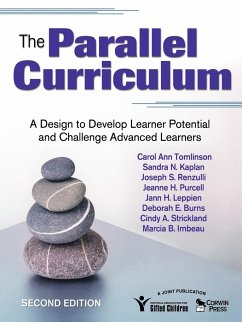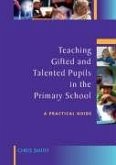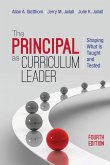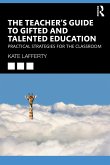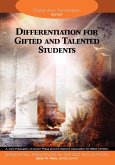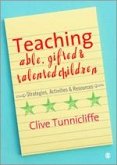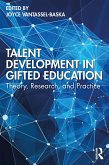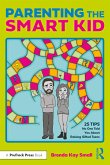Carol Ann Tomlinson, Sandra Kaplan, Joseph S. Renzulli
The Parallel Curriculum
A Design to Develop Learner Potential and Challenge Advanced Learners
Carol Ann Tomlinson, Sandra Kaplan, Joseph S. Renzulli
The Parallel Curriculum
A Design to Develop Learner Potential and Challenge Advanced Learners
- Broschiertes Buch
- Merkliste
- Auf die Merkliste
- Bewerten Bewerten
- Teilen
- Produkt teilen
- Produkterinnerung
- Produkterinnerung
Packed with sample units, rubrics, and more, this updated bestseller helps teachers develop and implement a curriculum that moves students along the continuum toward expertise.
Andere Kunden interessierten sich auch für
![Teaching Gifted and Talented Pupils in the Primary School Teaching Gifted and Talented Pupils in the Primary School]() Chris SmithTeaching Gifted and Talented Pupils in the Primary School60,99 €
Chris SmithTeaching Gifted and Talented Pupils in the Primary School60,99 €![The Principal as Curriculum Leader The Principal as Curriculum Leader]() Allan A. GlatthornThe Principal as Curriculum Leader44,99 €
Allan A. GlatthornThe Principal as Curriculum Leader44,99 €![The Teacher's Guide to Gifted and Talented Education The Teacher's Guide to Gifted and Talented Education]() Kate Lafferty (University of Melbourne)The Teacher's Guide to Gifted and Talented Education36,99 €
Kate Lafferty (University of Melbourne)The Teacher's Guide to Gifted and Talented Education36,99 €![Differentiation for Gifted and Talented Students Differentiation for Gifted and Talented Students]() Carol Ann TomlinsonDifferentiation for Gifted and Talented Students42,99 €
Carol Ann TomlinsonDifferentiation for Gifted and Talented Students42,99 €![Teaching Able, Gifted and Talented Children Teaching Able, Gifted and Talented Children]() Clive TunnicliffeTeaching Able, Gifted and Talented Children57,99 €
Clive TunnicliffeTeaching Able, Gifted and Talented Children57,99 €![Talent Development in Gifted Education Talent Development in Gifted Education]() Talent Development in Gifted Education62,99 €
Talent Development in Gifted Education62,99 €![Parenting the Smart Kid Parenting the Smart Kid]() Brenda Kay Small (USA Regis University)Parenting the Smart Kid29,99 €
Brenda Kay Small (USA Regis University)Parenting the Smart Kid29,99 €-
-
-
Packed with sample units, rubrics, and more, this updated bestseller helps teachers develop and implement a curriculum that moves students along the continuum toward expertise.
Hinweis: Dieser Artikel kann nur an eine deutsche Lieferadresse ausgeliefert werden.
Hinweis: Dieser Artikel kann nur an eine deutsche Lieferadresse ausgeliefert werden.
Produktdetails
- Produktdetails
- Verlag: SAGE Publications Inc
- Artikelnr. des Verlages: B61301P
- 2 Revised edition
- Seitenzahl: 334
- Erscheinungstermin: 22. Oktober 2008
- Englisch
- Abmessung: 280mm x 210mm x 18mm
- Gewicht: 832g
- ISBN-13: 9781412961318
- ISBN-10: 1412961319
- Artikelnr.: 25326168
- Herstellerkennzeichnung
- Libri GmbH
- Europaallee 1
- 36244 Bad Hersfeld
- gpsr@libri.de
- Verlag: SAGE Publications Inc
- Artikelnr. des Verlages: B61301P
- 2 Revised edition
- Seitenzahl: 334
- Erscheinungstermin: 22. Oktober 2008
- Englisch
- Abmessung: 280mm x 210mm x 18mm
- Gewicht: 832g
- ISBN-13: 9781412961318
- ISBN-10: 1412961319
- Artikelnr.: 25326168
- Herstellerkennzeichnung
- Libri GmbH
- Europaallee 1
- 36244 Bad Hersfeld
- gpsr@libri.de
Carol Ann Tomlinson's career as an educator includes 21 years as a public school teacher. She taught in high school, preschool, and middle school, and worked with heterogeneous classes as well as special classes for students identified as gifted and students with learning difficulties. Her public school career also included 12 years as a program administrator of special services for advanced and struggling learners. She was Virginia's Teacher of the Year in 1974. She is professor of educational leadership, foundations, and policy at the University of Virginia's Curry School of Education; a researcher for the National Research Center on the Gifted and Talented; a codirector of the University of Virginia's Summer Institute on Academic Diversity; and president of the National Association for Gifted Children. Special interests throughout her career have included curriculum and instruction for advanced learners and struggling learners, effective instruction in heterogeneous settings, and bridging the fields of general education and gifted education. She is author of over 100 articles, book chapters, books, and other professional development materials, including How to Differentiate Instruction in Mixed-Ability Classrooms, The Differentiated Classroom: Responding to the Needs of All Learners, Leadership for Differentiated Schools and Classrooms, the facilitator's guide for the video staff development sets called Differentiating Instruction, and At Work in the Differentiated Classroom, as well as a professional inquiry kit on differentiation. She works throughout the United States and abroad with teachers whose goal is to develop more responsive heterogeneous classrooms.
Preface to the Second Edition Acknowledgments About the Authors 1. The Rationale and Guiding Principles for an Evolving Conception of Curriculum A Word to New Readers About This Chapter Reasons for Another Curriculum Model Theoretical and Research-Based Underpinnings of the Parallel Curriculum Model 2. An Overview of the Parallel Curriculum Model A Look at the Four Curriculum Parallels The Core Curriculum The Curriculum of Connections The Curriculum of Practice The Curriculum of Identity Curriculum Combining the Four Parallels Planning Quality Curriculum Ensuring Fidelity to the Parallel Curriculum Model Looking Ahead in the Book 3. Thinking About the Elements of Curriculum Design The Big Picture Planning Quality Curriculum Some Key Components of Curriculum Design Components of a Comprehensive Curriculum Plan Content/Standards Assessment Introductory Activities Teaching Methods Learning Activities Grouping Strategies Products Resources Extension Activities Differentiation Based on Learner Need (Including AID) Lesson and Unit Closure Remodeling a Unit Using the Comprehensive Curriculum Framework: One Teacher
s Approach Looking Back and Ahead 4. The Core Curriculum Parallel Why Four Approaches to Curriculum Design? Isn
t One Good Enough? What Is "Core" in the Core Curriculum Parallel? How Are the Key Curriculum Components Reconfigured to Achieve the Goals of the Core Curriculum Parallel? Revising the Remaining Curriculum Components to Address the Goals of the Core Curriculum Parallel Using the Goals of the Core Curriculum Parallel and Key Curricular Elements for Lydia Janis
s Civil War Unit Looking Back and Ahead 5. The Curriculum of Connections Parallel What Is the Curriculum of Connections? The Purpose of a Curriculum of Connections: Why Should a Teacher Emphasize Connections and Relationships? The Curriclum of Connections: When Should I Use This Parallel? The Characteristics of the Curriculum Components Within the Curriculum of Connections Reconfiguring Other Curriculum Components for the Curriculum of Connections An Example of the Curriculum of Connections Using the Civil War Unit Looking Back and Ahead 6. The Curriculum of Practice Parallel What Does It Mean to "Practice" in a Curriculum? Why Does It Matter to Have Students Engage in the Curriculum of Practice? Key Features of the Components of Curriculum in the Curriculum of Practice? An Example of the Curriculum of Practice Using Lydiäs Civil War Unit Looking Back and Ahead 7. The Curriculum of Identity Parallel What Does Identity Mean in the Curriculum of Identity? Why Should We Be Concerned About a Student
s Identity? What Are the Key Features and Characteristics of Curriculum Components Within the Curriculum of Identity? An Example of the Curriculum of Identity Using Lydiäs Civil War Unit Looking Back and Ahead 8. Ascending Intellectual Demand in the Parallel Curriculum Model: The Journey Toward Expertise Ascending Intellectual Demand: The Path to Expertise Planning Backwards From Expertise Understanding the AID Continuum On the Continuum Novice On the Continuum Apprentice On the Continuum Practitioner On the Continuum Expert Transitions on the AID Continuum A Model for Planning Student Movement Along the AID Continuum The Novice in Science The Apprentice in Science The Practitioner in Science The Expert in Science Planning the Path Toward Expertise in Science The Novice in Mathematics The Apprentice in Mathematics The Practitioner in Mathematics The Expert in Mathematics The Novice in History The Apprentice in History The Practitioner in History The Expert in History The Novice in English and Language Arts The Apprentice in English and Language Arts The Practitioner in English and Language Arts The Expert in English and Language Arts Using the AID Continuum Resource A: Teaching Resources for Chapter 8 References Index
s Approach Looking Back and Ahead 4. The Core Curriculum Parallel Why Four Approaches to Curriculum Design? Isn
t One Good Enough? What Is "Core" in the Core Curriculum Parallel? How Are the Key Curriculum Components Reconfigured to Achieve the Goals of the Core Curriculum Parallel? Revising the Remaining Curriculum Components to Address the Goals of the Core Curriculum Parallel Using the Goals of the Core Curriculum Parallel and Key Curricular Elements for Lydia Janis
s Civil War Unit Looking Back and Ahead 5. The Curriculum of Connections Parallel What Is the Curriculum of Connections? The Purpose of a Curriculum of Connections: Why Should a Teacher Emphasize Connections and Relationships? The Curriclum of Connections: When Should I Use This Parallel? The Characteristics of the Curriculum Components Within the Curriculum of Connections Reconfiguring Other Curriculum Components for the Curriculum of Connections An Example of the Curriculum of Connections Using the Civil War Unit Looking Back and Ahead 6. The Curriculum of Practice Parallel What Does It Mean to "Practice" in a Curriculum? Why Does It Matter to Have Students Engage in the Curriculum of Practice? Key Features of the Components of Curriculum in the Curriculum of Practice? An Example of the Curriculum of Practice Using Lydiäs Civil War Unit Looking Back and Ahead 7. The Curriculum of Identity Parallel What Does Identity Mean in the Curriculum of Identity? Why Should We Be Concerned About a Student
s Identity? What Are the Key Features and Characteristics of Curriculum Components Within the Curriculum of Identity? An Example of the Curriculum of Identity Using Lydiäs Civil War Unit Looking Back and Ahead 8. Ascending Intellectual Demand in the Parallel Curriculum Model: The Journey Toward Expertise Ascending Intellectual Demand: The Path to Expertise Planning Backwards From Expertise Understanding the AID Continuum On the Continuum Novice On the Continuum Apprentice On the Continuum Practitioner On the Continuum Expert Transitions on the AID Continuum A Model for Planning Student Movement Along the AID Continuum The Novice in Science The Apprentice in Science The Practitioner in Science The Expert in Science Planning the Path Toward Expertise in Science The Novice in Mathematics The Apprentice in Mathematics The Practitioner in Mathematics The Expert in Mathematics The Novice in History The Apprentice in History The Practitioner in History The Expert in History The Novice in English and Language Arts The Apprentice in English and Language Arts The Practitioner in English and Language Arts The Expert in English and Language Arts Using the AID Continuum Resource A: Teaching Resources for Chapter 8 References Index
Preface to the Second Edition Acknowledgments About the Authors 1. The Rationale and Guiding Principles for an Evolving Conception of Curriculum A Word to New Readers About This Chapter Reasons for Another Curriculum Model Theoretical and Research-Based Underpinnings of the Parallel Curriculum Model 2. An Overview of the Parallel Curriculum Model A Look at the Four Curriculum Parallels The Core Curriculum The Curriculum of Connections The Curriculum of Practice The Curriculum of Identity Curriculum Combining the Four Parallels Planning Quality Curriculum Ensuring Fidelity to the Parallel Curriculum Model Looking Ahead in the Book 3. Thinking About the Elements of Curriculum Design The Big Picture Planning Quality Curriculum Some Key Components of Curriculum Design Components of a Comprehensive Curriculum Plan Content/Standards Assessment Introductory Activities Teaching Methods Learning Activities Grouping Strategies Products Resources Extension Activities Differentiation Based on Learner Need (Including AID) Lesson and Unit Closure Remodeling a Unit Using the Comprehensive Curriculum Framework: One Teacher
s Approach Looking Back and Ahead 4. The Core Curriculum Parallel Why Four Approaches to Curriculum Design? Isn
t One Good Enough? What Is "Core" in the Core Curriculum Parallel? How Are the Key Curriculum Components Reconfigured to Achieve the Goals of the Core Curriculum Parallel? Revising the Remaining Curriculum Components to Address the Goals of the Core Curriculum Parallel Using the Goals of the Core Curriculum Parallel and Key Curricular Elements for Lydia Janis
s Civil War Unit Looking Back and Ahead 5. The Curriculum of Connections Parallel What Is the Curriculum of Connections? The Purpose of a Curriculum of Connections: Why Should a Teacher Emphasize Connections and Relationships? The Curriclum of Connections: When Should I Use This Parallel? The Characteristics of the Curriculum Components Within the Curriculum of Connections Reconfiguring Other Curriculum Components for the Curriculum of Connections An Example of the Curriculum of Connections Using the Civil War Unit Looking Back and Ahead 6. The Curriculum of Practice Parallel What Does It Mean to "Practice" in a Curriculum? Why Does It Matter to Have Students Engage in the Curriculum of Practice? Key Features of the Components of Curriculum in the Curriculum of Practice? An Example of the Curriculum of Practice Using Lydiäs Civil War Unit Looking Back and Ahead 7. The Curriculum of Identity Parallel What Does Identity Mean in the Curriculum of Identity? Why Should We Be Concerned About a Student
s Identity? What Are the Key Features and Characteristics of Curriculum Components Within the Curriculum of Identity? An Example of the Curriculum of Identity Using Lydiäs Civil War Unit Looking Back and Ahead 8. Ascending Intellectual Demand in the Parallel Curriculum Model: The Journey Toward Expertise Ascending Intellectual Demand: The Path to Expertise Planning Backwards From Expertise Understanding the AID Continuum On the Continuum Novice On the Continuum Apprentice On the Continuum Practitioner On the Continuum Expert Transitions on the AID Continuum A Model for Planning Student Movement Along the AID Continuum The Novice in Science The Apprentice in Science The Practitioner in Science The Expert in Science Planning the Path Toward Expertise in Science The Novice in Mathematics The Apprentice in Mathematics The Practitioner in Mathematics The Expert in Mathematics The Novice in History The Apprentice in History The Practitioner in History The Expert in History The Novice in English and Language Arts The Apprentice in English and Language Arts The Practitioner in English and Language Arts The Expert in English and Language Arts Using the AID Continuum Resource A: Teaching Resources for Chapter 8 References Index
s Approach Looking Back and Ahead 4. The Core Curriculum Parallel Why Four Approaches to Curriculum Design? Isn
t One Good Enough? What Is "Core" in the Core Curriculum Parallel? How Are the Key Curriculum Components Reconfigured to Achieve the Goals of the Core Curriculum Parallel? Revising the Remaining Curriculum Components to Address the Goals of the Core Curriculum Parallel Using the Goals of the Core Curriculum Parallel and Key Curricular Elements for Lydia Janis
s Civil War Unit Looking Back and Ahead 5. The Curriculum of Connections Parallel What Is the Curriculum of Connections? The Purpose of a Curriculum of Connections: Why Should a Teacher Emphasize Connections and Relationships? The Curriclum of Connections: When Should I Use This Parallel? The Characteristics of the Curriculum Components Within the Curriculum of Connections Reconfiguring Other Curriculum Components for the Curriculum of Connections An Example of the Curriculum of Connections Using the Civil War Unit Looking Back and Ahead 6. The Curriculum of Practice Parallel What Does It Mean to "Practice" in a Curriculum? Why Does It Matter to Have Students Engage in the Curriculum of Practice? Key Features of the Components of Curriculum in the Curriculum of Practice? An Example of the Curriculum of Practice Using Lydiäs Civil War Unit Looking Back and Ahead 7. The Curriculum of Identity Parallel What Does Identity Mean in the Curriculum of Identity? Why Should We Be Concerned About a Student
s Identity? What Are the Key Features and Characteristics of Curriculum Components Within the Curriculum of Identity? An Example of the Curriculum of Identity Using Lydiäs Civil War Unit Looking Back and Ahead 8. Ascending Intellectual Demand in the Parallel Curriculum Model: The Journey Toward Expertise Ascending Intellectual Demand: The Path to Expertise Planning Backwards From Expertise Understanding the AID Continuum On the Continuum Novice On the Continuum Apprentice On the Continuum Practitioner On the Continuum Expert Transitions on the AID Continuum A Model for Planning Student Movement Along the AID Continuum The Novice in Science The Apprentice in Science The Practitioner in Science The Expert in Science Planning the Path Toward Expertise in Science The Novice in Mathematics The Apprentice in Mathematics The Practitioner in Mathematics The Expert in Mathematics The Novice in History The Apprentice in History The Practitioner in History The Expert in History The Novice in English and Language Arts The Apprentice in English and Language Arts The Practitioner in English and Language Arts The Expert in English and Language Arts Using the AID Continuum Resource A: Teaching Resources for Chapter 8 References Index

